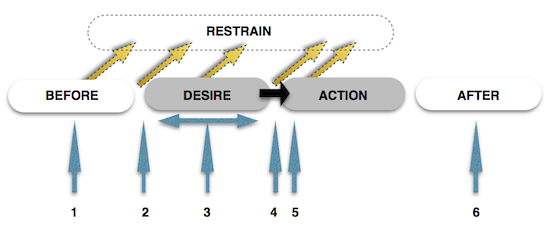Presented at The Developing Group 3 Oct 2015
What do the following metaphors have in common?
Self-discipline
Control myself
Not give in to …
Hold myself back
Control my desire
Use my will power
Curtail the impulse
Resist the attraction
Overcome my tendencies
Keep my hankering in check
Withhold permission from myself
Show strength of character
Counter the compulsion
Repress my desires
Enforce my resolve
Turn my back on it
Manage the urge
Restrain myself
Master myself
Fight the pull
Be prudent
Background
This year we qualified as therapists for StopSo (Specialist Treatment Organisation for the Prevention of Sexual Offending). StopSo works with those at risk of sexual offending or re-offending to enable them to stop acting illegally, thus reducing the risk to society and lessening the number of victims. They also work with the families of sex offenders who have to come to terms with being related to a sex offender.
Are you aware that many people who have a sexual attraction that would be illegal if acted on live their whole lives and never act on it? And that many that have offended learn how not to offend again even though they continue to have the attraction? We want to find out how these people consistently do not act on their desires. As a result we have decided to engage in a research project modelling how people do not commit sexual offenses when they have the desire to do so.
Although we are using the metaphor of ‘self-restraint’ to cover these processes, the list above shows there are many ways to embody the internal behaviour. We have a hunch that restraining oneself from sexual offending may have a similar structure to self-restraining other illegal activities such as stealing, speeding, fraud, physical assault, etc. And possibly also restraining ourselves from ‘immoral’ acts such as cheating, lying, manipulating; and from unhealthy behaviours – addictions are prime candidates.
Consider for a moment: Have you experienced the desire or attraction to do something illegal, immoral or unhealthy – and not acted on that desire? If so, how did you do that?
We believe the results of modelling the structure of self-restraint could apply in many areas and there will be no lack of applications!
Purpose of the day
At the October 3rd Developing Group we investigated how to model ‘self-restraint’, i.e. How can we best cleanly facilitate people to access and describe how they self-restrain – when they have the desire to act in a way they would rather not?
Not only what happens in the moment when there is the potential to act, but also how to restraint is maintained over the longer term – regardless of temptations. What questions and prompts will invite an exemplar’s attention to go to relevant places in their experience?
Definitions of ‘restrain’
- to prevent (someone or something) from doing something
- to keep under control or within limits
- to control (a strong urge or emotion)
- to deprive (someone) of freedom of movement or personal liberty
Charles restrained his anger: control, keep under control, check, hold/keep in check, curb, suppress, repress, contain, keep within bounds, limit, regulate, restrict, moderate, dampen, put a brake on, subdue, smother, choke back, stifle, bridle, leash, bit, muzzle, bottle up, cork, rein back, rein in, keep in; informal keep the lid on. ANTONYMS provoke, encourage.
She had to restrain herself from slamming the receiver down: prevent, stop, keep, hold back; hinder, impede, hamper, restrict, constrain, obstruct; archaic hold. ANTONYMS force.
Law: a court could restrain a doctor from continuing treatment: prohibit, ban, bar, disallow, interdict; forbid, veto, proscribe; Law enjoin. ANTONYMS compel, encourage.
The insane used to be restrained with (by) straitjackets: tie up, bind, strap, truss, pinion, lash, tether, chain (up), fetter, shackle, manacle, put in irons, handcuff.
The process of desiring to act and taking action - or not
Below is a simplified model of how many people perceive the process of desiring to act and taking action – or not. (We are not saying this is how the process work, we are saying this is how many people conceptualise it.) A person who self-restrains will in some way interrupt the sequence which leads to acting illegally or immorally. Where in the sequence, and how they do that is what we want to model from our exemplars.
And remember, the purpose of the day is at one level higher than this, it is about learning how to do the modelling of a subject like this.
Likely times/places where an exemplar could intervene such that the offending behaviour does not (re)occur :
1. Before there is any (awareness of) desire i.e. when they are in another pattern
2. Just before the first inkling of desire (sometimes called a ‘trigger’)
3. During the process of desiring
4. Between desire and action
5. Beginning to take action
6. After, i.e. self-reflection and feedback on what happened.

Further background reading:
Inhibition: The art-of systemic balancing
And information about clean interviewing:
Clean Language in Research Interviews
Answer to above quiz:
If these states are desired then examples 17-21 are Outcomes, the rest are Remedies.







